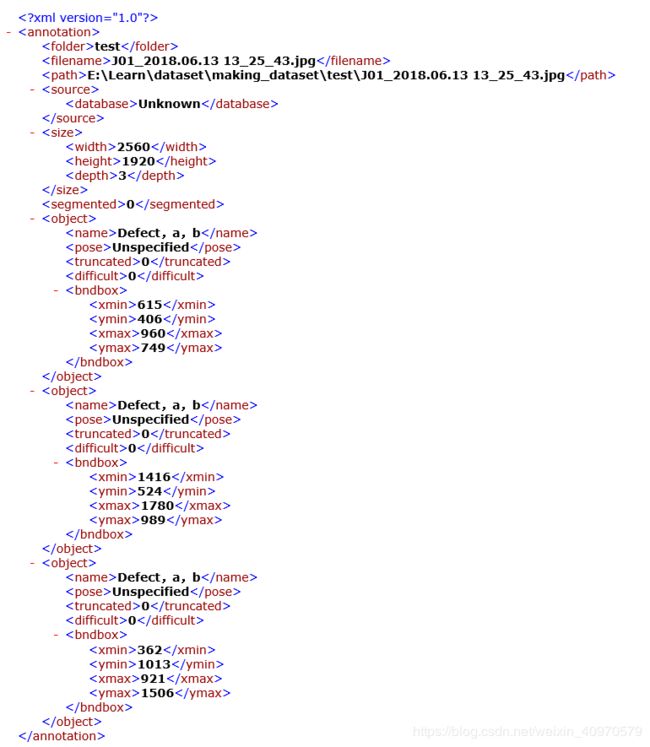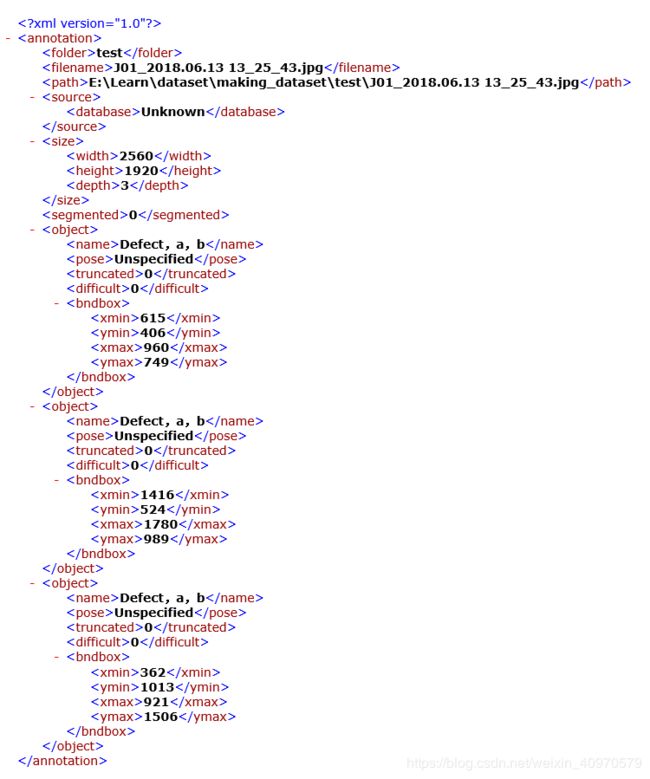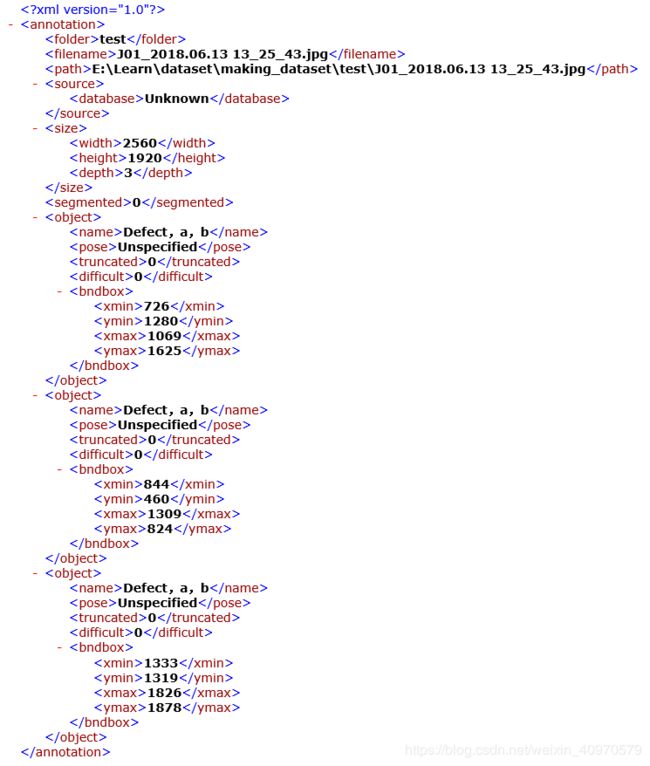Come on和我一起做基于深度学习的缺陷检测一(数据准备2)
基于深度学习的织物疵点检测
- Pascal-Voc格式数据集
- Pascal_Voc中.xml格式数据集增强
- 这样就可以实现Pascal_Voc格式的数据标注和增强了
Pascal-Voc格式数据集
和上一个博客一样,同样是通过精灵标注助手,可以直接生成Pascal-Voc格式的数据,具体如下图所示。

文件属性都是 .xml 格式的文件,里面的内容有些许的差异,下面来看看如何用Python生成这个文件
# -*- coding: utf-8 -*-
from lxml import etree
import numpy as np
import xml.etree.ElementTree as ET
import math
import os
# 创建 xml格式 文件
def creat_pascal_voc_xml(xml_file, x, y, w, h):
"""
新建xml文件
:param xml_file: xml
:param x: xmin
:param y: ymin
:param w: 宽
:param h: 高
:return:
"""
annotation = etree.Element("annotation")
folder = etree.SubElement(annotation, "folder")
folder.text = 'DaiSha'
filename = etree.SubElement(annotation, "filename")
filename.text = 'DaiSha_028.jpg'
path = etree.SubElement(annotation, "path")
path.text = "E:\Learn\dataset\making_dataset\DaiSha\DaiSha_028.jpg"
source = etree.SubElement(annotation, "source")
database = etree.SubElement(source, "database")
database.text = 'Unknown'
size = etree.SubElement(annotation, 'size')
width = etree.SubElement(size, 'width')
width.text = '512'
height = etree.SubElement(size, 'height')
height.text = '512'
depth = etree.SubElement(size, 'depth')
depth.text = '3'
segmented = etree.SubElement(annotation, "segmented")
segmented.text = '0'
object = etree.SubElement(annotation, 'object')
name = etree.SubElement(object, 'name')
name.text = 'DaiSha'
pose = etree.SubElement(object, 'pose')
pose.text = 'Unspecified'
truncated = etree.SubElement(object, 'truncated')
truncated.text = '0'
difficult = etree.SubElement(object, 'difficult')
difficult.text = '0'
bndbox = etree.SubElement(object, 'bndbox')
xmin = etree.SubElement(bndbox, "xmin")
xmin.text = str(x)
ymin = etree.SubElement(bndbox, "ymin")
ymin.text = str(y)
xmax = etree.SubElement(bndbox, "xmax")
xmax.text = str(x + w)
ymax = etree.SubElement(bndbox, "ymax")
ymax.text = str(y + h)
tree = etree.ElementTree(annotation)
tree.write(xml_file, pretty_print=True, xml_declaration=False, encoding='utf-8')
return xml_file
xx = creat_pascal_voc_xml('ss.xml', 32, 120, 80, 80)
Pascal_Voc中.xml格式数据集增强
这个数据增强适用于xml文件,增强的方式和 Come on和我一起做基于深度学习的缺陷检测一(数据准备)相同。同样适用于多个标注疵点的数据。下面直接上代码。
# -*- coding: utf-8 -*-
# 作者:大大玮在路上
# 图像和对应的xml文件扩充
import numpy as np
import xml.etree.ElementTree as ET
import math
import os
from tqdm import tqdm
import cv2
def edit_xml(xml_file, model, angle):
'''
修改xml文件,对于数据标注来说,我们改的格式主要就是以下两点:
1. name
2. bndbox
因此,封好的函数主要也是围绕这两个变化而实现的功能
1. 图像标注完成后,经图像旋转、翻转后的新的xml文件的生成.
这里我是做缺陷检测的,所以说缩放、增强对比度、直方图均衡化之类的对我没啥用,我就不写了
:param xml_file:xml文件的路径
:
:return:
:param xml_file: 文件的路径
:param model: 图像变换模式,rotate:图像旋转,angle可以为90,180,270,-90,-180,-270
flip:图像翻转,angle可以为0:水平翻转;1:垂直翻转;-1:先水平后垂直翻转
:param angle:
:return:
'''
global x, y, x_w, y_h, w_total, h_total
tree = ET.parse(xml_file) # 读取 xml 文件
tree.getroot()
for size in tree.iter('size'):
for w in size.iter('width'):
w_total = int(w.text)
for h in size.iter('height'):
h_total = int(h.text)
for object in tree.iter('object'):
for bndbox in object.iter('bndbox'):
for xmin in bndbox.iter('xmin'):
x = int(xmin.text)
for ymin in bndbox.iter('ymin'):
y = int(ymin.text)
for xmax in bndbox.iter('xmax'):
x_w = int(xmax.text)
for ymax in bndbox.iter('ymax'):
y_h = int(ymax.text)
print(x,y)
w_1 = x_w - x
h_1 = y_h - y
anglePi = angle * math.pi / 180.0
cosA = math.cos(anglePi)
sinA = math.sin(anglePi)
print( x, y, x_w, y_h, w_total, h_total)
center_array = np.array([[1, 0, 0],
[0, -1, 0],
[-0.5 * w_total, 0.5 * h_total, 1]
])
i_center_array = np.array([[1, 0, 0],
[0, -1, 0],
[0.5 * w_total, 0.5 * h_total, 1]
])
rotate_array = np.array([[cosA, sinA, 0],
[-sinA, cosA, 0],
[0, 0, 1]
])
rotate = np.dot(center_array, rotate_array)
i_rotate = np.dot(rotate, i_center_array)
# 逆时针旋转
if model == 'rotate':
new_min = np.dot(np.array([x, y, 1]), i_rotate)
x_new = new_min[0]
y_new = new_min[1]
print(angle)
if angle == 90 or angle == -270:
x_min = x_new
y_min = y_new - w_1
x_max = x_new + h_1
y_max = y_new
elif angle == 180 or angle == -180:
x_min = x_new - w_1
y_min = y_new - h_1
x_max = x_new
y_max = y_new
elif angle == 270 or angle == -90:
x_min = x_new - h_1
y_min = y_new
x_max = x_new
y_max = y_new + w_1
for xmin in bndbox.iter('xmin'):
xmin.text = str(int(x_min))
for ymin in bndbox.iter('ymin'):
ymin.text = str(int(y_min))
for xmax in bndbox.iter('xmax'):
xmax.text = str(int(x_max))
for ymax in bndbox.iter('ymax'):
ymax.text = str(int(y_max))
# 镜像翻转
elif model == 'flip':
new_min = np.dot(np.array([x, y, 1]), center_array)
x_new = new_min[0]
y_new = new_min[1]
# 水平翻转
if angle == 0:
x_min = -x_new - w_1
y_min = y_new
x_max = -x_new
y_max = y_new - h_1
# 垂直翻转
elif angle == 1:
x_min = x_new
y_min = -y_new + h_1
x_max = x_new + w_1
y_max = -y_new
# 先水平后垂直
elif angle == -1:
x_min = -x_new - w_1
y_min = -y_new + h_1
x_max = -x_new
y_max = -y_new
result_min = np.dot(np.array([x_min, y_min, 1]), i_center_array)
result_max = np.dot(np.array([x_max, y_max, 1]), i_center_array)
print(result_max,result_min)
for xmin in bndbox.iter('xmin'):
xmin.text = str(int(result_min[0]))
print(str(int(result_min[0])))
for ymin in bndbox.iter('ymin'):
ymin.text = str(int(result_min[1]))
for xmax in bndbox.iter('xmax'):
xmax.text = str(int(result_max[0]))
for ymax in bndbox.iter('ymax'):
ymax.text = str(int(result_max[1]))
else:
print('Model Error!!')
path = 'E:/Learn/dataset/Making_dataset/' # 文件存储的路径
name = os.path.basename(xml_file)
file_name = name.split('.')[0]
tree.write(path + file_name + str('_') + model + str('_') + str(angle) + '.xml')
def image_increase(image_path, model, angle):
'''
:param image_path:输入图像
:param model:rotate:图像旋转,flip:图像翻转
:param angle: 90,180,270,-90,-180,-270,0,1,-1
:return:
'''
image = cv2.imread(image_path)
angle_rotate = [90, 180, 270, -90, -180, -270]
angle_flip = [0, 1, -1]
height, width, channels = image.shape
if model == 'rotate':
angle_rotate = set(angle_rotate)
if angle in angle_rotate:
matRotate = cv2.getRotationMatrix2D((height * 0.5, width * 0.5), angle, 1)
img = cv2.warpAffine(image, matRotate, (height, width))
elif model == 'flip':
angle_flip = set(angle_flip)
if angle in angle_flip:
img = cv2.flip(image, angle)
else:
img = image
print('The angle number is error! Please input True-angle!')
path = 'E:\Learn\dataset\Making_dataset/' # 文件存储的路径
name = os.path.basename(image_path)
file_name = name.split('.')[0]
cv2.imwrite(path + file_name + str('_') + model + str('_') + str(angle) + '.jpg', img)
if __name__ == '__main__':
# 这里要保证图像增强和对应的xml标注文件对应,所以命名两个变量
model = 'flip'
angle = 0
# 标注文件增强
path_xml = r'xml文件路径'
xml_files = [os.path.join(rootdir, file) for rootdir, _, files in os.walk(path_xml) for file in files if
(file.endswith('.xml'))]
for pathed in xml_files:
head = os.path.join(pathed)
edit_xml(pathed, model, angle)
# 图像增强
path_image = r'图片路径'
img_files = [os.path.join(rootdir, file) for rootdir, _, files in os.walk(path_image) for file in files if
(file.endswith('.jpg'))]
for pathed in img_files:
head = os.path.join(pathed)
image_increase(head, model, angle)
这样就可以实现单个标注和多个标注信息的增强了,下面看看多个标注信息增强后效果图。
先是原来的数据

然后是经过逆时针旋转90°后的数据
